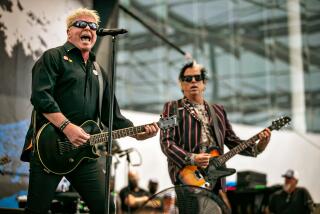The Clash manifesto
- Share via
Despite its influence, the Clash has inspired only a handful of books. There’s Marcus Gray’s group history “Return of the Last Gang in Town,” tour manager Johnny Green’s memoir “A Riot of Our Own,” Pat Gilbert’s “Passion Is a Fashion” and Chris Salewicz’s biography of Joe Strummer, “Redemption Song.” It’s a pretty thin shelf for the group that billed itself as “the only band that matters” and that, in the five-year whirlwind of its prime, produced three of the most monumental albums of the punk era, one of which (“London Calling”) belongs on anybody’s shortlist of the greatest rock records of all time.
And yet, as “The Clash” (Grand Central: 384 pp., $45) makes clear, the band’s true legacy may be that it couldn’t be encapsulated, that the stridency of its politics and the power of its performances had to be experienced on their own terms. Certainly, that’s the idea behind this book, which comes credited to the group’s four main members (Joe Strummer, Mick Jones, Paul Simonon, Topper Headon), although Strummer died in 2002.
A mash-up of interviews and commentary, lavishly illustrated with tour and studio photos, promotional fliers, album covers and even a French comic strip, this is more scrapbook than exegesis, a collage spanning the years from 1976, when the Clash was formed, to 1983, when Strummer fired Jones and effectively ended the group’s supernova run.
If you know the story, there’s not much new here, but it is fun to read it in the band members’ words. And the editors get points for ending in 1983, rather than limping along, as the Clash did, until 1985, when in the wake of the egregious “Cut the Crap,” Strummer and Simonon -- the last members standing -- called it quits.
-- David L. Ulin
More to Read
Sign up for our Book Club newsletter
Get the latest news, events and more from the Los Angeles Times Book Club, and help us get L.A. reading and talking.
You may occasionally receive promotional content from the Los Angeles Times.








